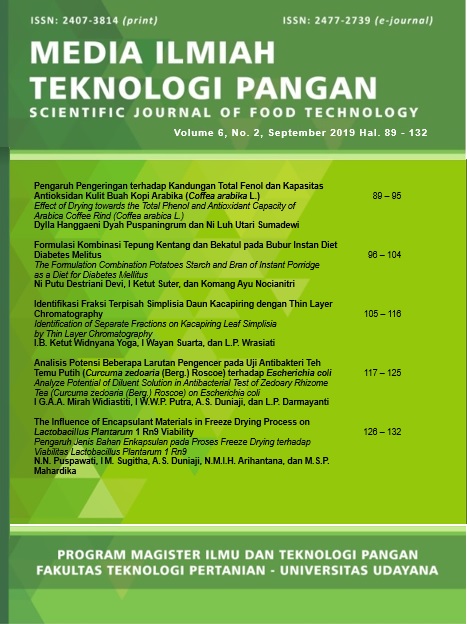The Influence of Encapsulant Materials in Freeze Drying Process on Lactobacillus plantarum 1 RN9 Viability
Abstract
Lactic acid bacteria are important microorganisms in food fermentation technology. Lactobacillus plantarum 1 RN9 is a LAB isolated from bamboo and can be used as a starter culture in making curd. During the processing of LAB culture it can be damaged so that it can eliminate its function as a probiotic. On the other hand, storing culture in a fresh condition cannot be carried out for a long time. Thus we need a preservation method (preservation) of lactic acid bacteria that can maintain its viability and superior of the properties of an isolate. Encapsulation is one way to maintain the viability of probiotics and protect probiotics from damage due to unfavorable environmental conditions such as gastric acid and bile salts (Wu et al., 2000). The purpose of this study was to determine the effect of the type of encapsulant on the yield and viability of L. plantarum 1 RN9 during the freeze drying (FD) process. The encapsulant material used was skim milk, lactose, maltodextrin with observational parameters including yield, total LAB and viability of LAB. Based on the results of the study showed that the yield of dry cultures of L. plantarum 1 RN9 ranged from 26.42% to 41.08%, which statistically showed a significant difference (P> 0.05) between treatments. The highest yield was obtained in skim milk encapsulant by 41.08% then lactose was 39.44% and maltodextrin 26.42%. The viability of L. plantarum 1 RN9 culture after freeze drying with lactose encapsulant and maltodextrin decreased by 2.3 to 2.5 log cycles but still had high viability while viability with skim milk encapculation increase. The total LAB with skim milk encapsulants increased by 1 log cycle from 10.3 log CFU/g to 11.3 log CFU/g. Based on the results of the studyit can be conclused the use of skim milk encapsulants on L. plantarum 1 RN9 gives the best results compared of lactose and matodextrin with a yield of 41.08% and viability increases 1 log cycles ie 1.6 x 1011 CFU/g.








